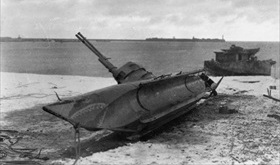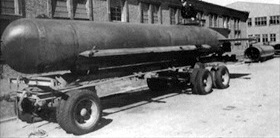NAZIS DEPLOY MIDGET U-BOAT IN FRANCE
Off the Normandy Coast, Occupied France · May 29, 1944
The German Kriegsmarine possessed several notable midget submarines (Kleinst-U-Boote), one being the one-man Biber (German for “beaver”) and the other the two-man Seehund (German for “seal”). Neither U‑boot was particularly successful as a weapon against Allied supply and troop ships. Influenced by a captured one-man British submarine, a prototype Biber was in place in March 1944 and successfully tested on this date in 1944. Hastily developed to help meet the impending Allied invasion of Europe (Operation Overlord), which began in Normandy on June 6, the one-man, 6.5‑ton Biber was the smallest submarine, at 29 feet long, in the Kriegsmarine. The Biber was powered by dual propulsion diesel (surfaced) and electric (submerged) motors. Its top speed submerged was 5.3 knots, and it had a range of 100 nautical miles on the surface. A conning tower contained armored glass windows to allow the pilot to see out, plus it had a 5‑ft periscope. Armed with two externally mounted torpedoes, two mines, or one of each, over 320 boats were delivered to the German navy. The first Biber operation, consisting of 22 boats, was launched on August 30, 1944, east of the Normandy beachheads. Only two boats reached their operational area. In December 1944 the Bibers were deployed to Rotterdam in the Netherlands to target Allied traffic to Antwerp, the Belgian port the Allies had recently wrestled away from the Wehrmacht. The first Biber attack took place on the night of December 22, 1944, in support of the German drive through the Ardennes Forest known as the Battle of the Bulge (December 16, 1944, to January 25, 1945). One Allied cargo ship, the Alan A. Dale, was sunk, its 65 crewmen rescued. Operations through December 25 achieved no success and none of the 14 deployed midget submarines survived. Losses at sea at the end of January, combined with Royal Air Force bombing of launch sites, prevented attacks from being mounted in February 1945. The last Biber mission was a mine-laying operation and took place on the night of April 26, four days short of Adolf Hitler’s suicide. Of the four Bibers that took part in the operation, one ran aground and three were attacked by P‑47 Thunderbolts, which sank two of them. With a loss rate of 69 percent, the Biber midget submarine can truly be described as a sailor’s coffin.
[amazon_carousel widget_type=”ASINList” width=”600″ height=”200″ title=”Recommended Reading” market_place=”US” shuffle_products=”False” show_border=”False” asin=”1861762798,0304354546,1840675217,1932033432,1472801229,1844154408,1591143691,1904687962,030681160X,1849081735″ /]
Kriegsmarine Midget Submarines
 |  |
Right: The one-man, 6.5-ton Biber, shown beached in this photo, was the smallest of 11 production and prototype submarines in the Kriegsmarine. Germany, Japan, and Italy built approximately 2,000 midget submarines (i.e., undersea vessels of less than 50 tons). Crewed by 1–4 men and armed with either torpedoes and/or mines, these miniature submarines performed both special and conventional operations in the Mediterranean, Black Sea, Indian Ocean, North Sea, the English Channel, and Pacific, including at Pearl Harbor.
![]()
Left: A damaged and abandoned Biber on its transportation trailer, 1945.
 |  |
Left: A far more successful undersea weapon than the Biber was the two-man Seehund (pl., Seehunde). At 39 ft long the Seehund had a submerged speed of 7 knots (under 8 mph), had dual propulsion diesel (surfaced) and electric (submerged) motors, and had a range of 270 or so nautical miles. From January to April 1945, Seehunde performed 142 sorties, during which they sank eight ships (versus one sinking for the Biber) for a total of 17,301 tons and damaged three for a total of 18,384 tons. They lost 35 of their own out of the 138 or so commissioned into the Kriegsmarine.
![]()
Right: The Molch (Salamander) was an 11‑ton, one-man, all-electric boat designed for coastal operations. Looking like a large torpedo, the Molch had a small range (40 miles at 5 knots), traveled submerged, and carried two underslung torpedoes. A total of 393 such boats were delivered to the Kriegsmarine. Molche (plural form) were used in the Mediterranean against the Allied invasion of the south of France (Operation Dragoon). On the night of September 25/26, 1944, a flotilla of 12 neither sank nor damaged anything for the loss of 10 subs. The last two subs were destroyed in Allied warship bombardment of San Remo, Italy, shortly thereafter.
German and Italian Sneak Craft. U.S. Navy Film Includes Descriptions of Biber and Seehund As Well As Torpedo Boats
![]()

 History buffs, there is good news! The Daily Chronicles of World War II is now available as an ebook for $4.99 on Amazon.com. Containing a year’s worth of dated entries from this website, the ebook brings the story of this tumultuous era to life in a compelling, authoritative, and succinct manner. Featuring inventive navigation aids, the ebook enables readers to instantly move forward or backward by month and date to different dated entries. Simple and elegant! Click
History buffs, there is good news! The Daily Chronicles of World War II is now available as an ebook for $4.99 on Amazon.com. Containing a year’s worth of dated entries from this website, the ebook brings the story of this tumultuous era to life in a compelling, authoritative, and succinct manner. Featuring inventive navigation aids, the ebook enables readers to instantly move forward or backward by month and date to different dated entries. Simple and elegant! Click 











